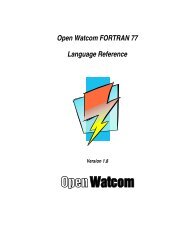Relocatable Object Module Format (OMF) Specification
Relocatable Object Module Format (OMF) Specification
Relocatable Object Module Format (OMF) Specification
Create successful ePaper yourself
Turn your PDF publications into a flip-book with our unique Google optimized e-Paper software.
<strong>Relocatable</strong> <strong>Object</strong> <strong>Module</strong> <strong>Format</strong><br />
9CH or 9DH FIXUPP—Fixup Record<br />
Description<br />
The FIXUPP record contains information that allows the linker to resolve (fix up) and eventually relocate<br />
references between object modules. FIXUPP records describe the LOCATION of each address value to be fixed<br />
up, the TARGET address to which the fixup refers, and the FRAME relative to which the address computation is<br />
performed.<br />
History<br />
Record type 9DH was added for 32-bit linkers; it has a Target Displacement field of 32 bits rather than 16 bits, and<br />
the Location field of the Locat word has been extended to 4 bits (using the previously unused higher order S bit) to<br />
allow new LOCATION values of 9, 11, and 13.<br />
Record <strong>Format</strong><br />
1 2 1<br />
9C Record THREAD subrecord or Checksum<br />
or 9D Length FIXUP subrecord<br />
<br />
Each subrecord in a FIXUPP object record either defines a thread for subsequent use, or refers to a data location<br />
in the nearest previous LEDATA or LIDATA record. The high-order bit of the subrecord determines the subrecord<br />
type: if the high-order bit is 0, the subrecord is a THREAD subrecord; if the high-order bit is 1, the subrecord is a<br />
FIXUP subrecord. Subrecords of different types can be mixed within one object record.<br />
Information that determines how to resolve a reference can be specified explicitly in a FIXUP subrecord, or it can<br />
be specified within a FIXUP subrecord by a reference to a previous THREAD subrecord. A THREAD subrecord<br />
describes only the method to be used by the linker to refer to a particular target or frame. Because the same<br />
THREAD subrecord can be referenced in several subsequent FIXUP subrecords, a FIXUPP object record that<br />
uses THREAD subrecords may be smaller than one in which THREAD subrecords are not used.<br />
THREAD subrecords can be referenced in the same object record in which they appear and also in subsequent<br />
FIXUPP object records.<br />
THREAD Subrecord<br />
There are four FRAME threads and four TARGET threads; not all need be defined, and they can be redefined by<br />
later THREAD subrecords in the same or later FIXUPP object records. The FRAME threads are used to specify<br />
the Frame Datum field in a later FIXUP subrecord; the TARGET threads are used to specify the Target Datum<br />
field in a later FIXUP subrecord.<br />
A THREAD subrecord does not require that a previous LEDATA or LIDATA record occur.<br />
The layout of the THREAD subrecord is as follows:<br />
<br />
0 D 0 Method Thred Index<br />
1 1 1 3 2 (bits) <br />
Tool Interface Standards (TIS) <strong>OMF</strong> <strong>Specification</strong>, Version 1.1 43
















